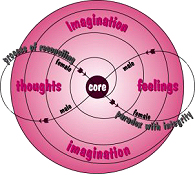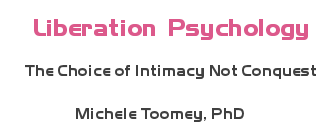Education in A Communication Context
© 1999 Michele Toomey, PhD
The frustration, self-doubt,alienation and anger that accompanies lack of success in school, whether academic or social, is as loud, if not louder, than any intellectual ability, learning disability or learning style a student has when s/he seeks admission to a school. Therefore, I propose we incorporate our academic programs into a communication context, providing students and faculty with courses, groups, and training in self-expression with accountability. In this context, education is viewed as an exchange of ideas that must include an exchange between the individuals involved, not just an intellectual discourse focussed on content alone.
I propose to create an environment where self-disclosure is expected and respected, and have designed a program to teach students how to express themselves with honesty and fairness so that they can be heard with caring and respect. It also teaches them how to listen the same way, so that they can give as well as receive. I call this kind of exchange "self-expression with accountability".
In this approach, process is paramount. It is an approach that tries to use the information gained from self-expression with accountability to move things along so that patterns and students stuck in patterns can change. I recognize only too well that what students are distracted by and how they feel about things affects their ability to listen and their desire to learn. The proposed intervention is accountable communication.
Participation in communication groups is one aspect of this approach These groups run in size from 8 - 10 students and 3 or 4 faculty members, and students receive a course credit for them. Principles of self-expression with accountability are taught, and then students and faculty are given the opportunity to express how they are feeling and what they are thinking about themselves and things that are happening to them. Expressions of blaming, accusations, and ridicule are re-phrased, and students and faculty are taught how to express themselves and how to listen to others and have a conversation, not an argument.
The purpose of the disclosures is for clarity and insight which lead to intimacy and understanding. This approach to communication and to each other carries over into the classroom where a more effective orientation toward teaching can occur. It asks faculty to teach students the course, not to teach the course to students. When we individualize our teaching, we are beginning by knowing the individual we are teaching with the intent of meeting her/him where she/he is and then leading him/her where we think she/he needs to be with the course.
Accountability is a central theme of honest communication. Acting out verbally and physically is a common pattern among adolescents. Left unaddressed, this pattern interferes with or prevents them from expressing their true feelings and in turn, interferes with or prevents them from knowing what they are saying. They, of course, get only more frustrated by the responses they then get, and none of the involved parties feel heard or cared about in any meaningful or effective way.
In this era of global violence, teenagers mirror the societal tone and approach themselves and each other with aggressive hostility and suspicion. They are surrounded by cultures that increasingly are verbally and physically abusive. Fairness and respect are not the valued norm in this last decade of the 20th century, and our youth are a product of this dearth of human caring. Many come to us withdrawn and cynical, hostile and resistant or determined to prove to themselves they can't and won't choose to join any community, certainly not a school community that represents a reminder of their failure to succeed.
Therefore, one recommendation is that there be an accountability committee that meets weekly and is chaired by someone trained to facilitate the process. The committee is comprised of an administrator, a faculty member, and two students. Anyone who has been unsuccessful in confronting another student, faculty member, or administrator, and wants help from the accountability committee, can bring that person or persons to the committee. Anyone can attend the meeting and participate in the discussion and confrontation, since it is to better understand the problem and creatively resolve it by determining the accountability each person has for the lack of resolution. Recommendations are made, and sometimes consequences result, and the parties involved are brought back to the committee each week thereafter, until some change occurs. It is my intention that issues be resolved to the satisfaction of all involved.
This experience is one of the most valuable opportunities that can be offered to students and faculty. They learn how to express negative feelings in a safe environment that demands fairness and respect. They learn to listen and discover why things happen and respect the fact that by understanding someone and something, they may be better able to relate to them, not just react to them. They also learn self-discipline and self-respect. Self-indulged verbal and physical outbursts are addressed, and, in confrontation, hopefully better understood and, therefore, better prevented and handled.
Another possible dimension of the communications context is student/faculty forums, where feelings are expressed and current issues in the school are discussed, and students and faculty ask each other for accountability. Always, we are trying to create the climate of fairness, respect and trust, so that students can work through and out of the feelings and patterns they have which have prevented them in the past from maximizing their talents, developing their interests, and successfully completing their educational goals.
By designing an academic program in the context of a communication program, I feel we are offering students a unique opportunity to learn how to free themselves from the patterns that have prevented them from expressing who they really are underneath the facades they have developed. It encourages our students to value, not disdain, who they really are, and then, because they are not so invested in their own alienation, they can be open to the educational process. They can discover what they want and need and how to get it.
I am proud to propose academics in this communication context, and when schools claim they individualize their teaching, it means they have a system in place that is actually designed to let them know their students individually so that they can actually tailor their approach and their teaching to them.
|



